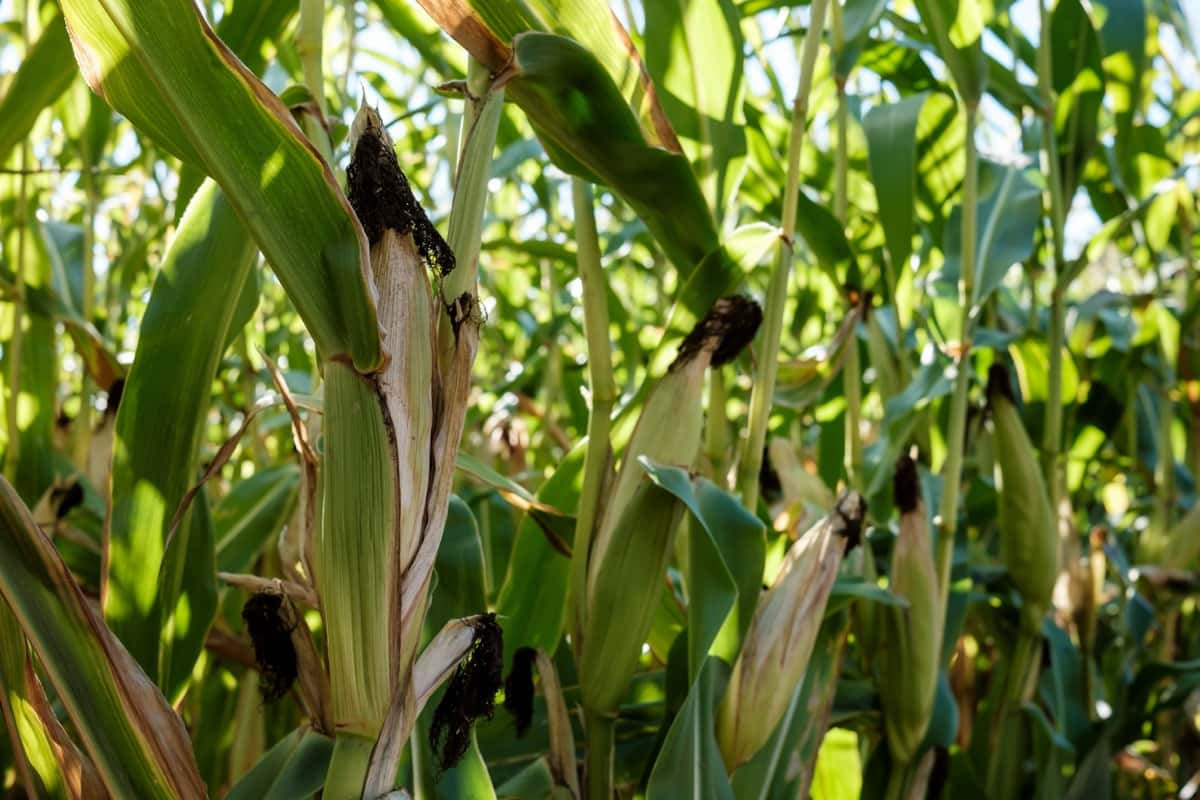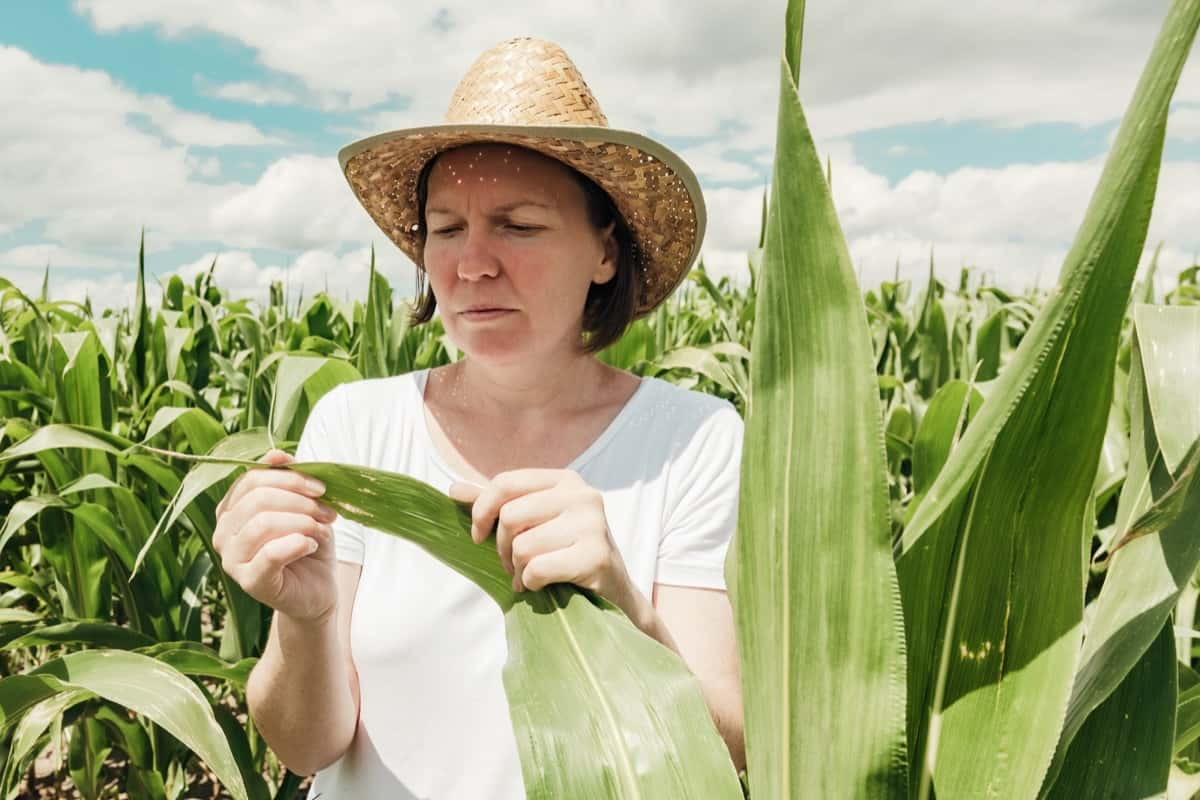Maize (Zea mays) is one of the important staple crops in the world, providing food, feed, and fuel for millions of people. It’s widely grown in tropical and subtropical regions and is known for its high yield potential and versatility. Bacterial stalk rot is a disease that affects maize plants and can significantly reduce crop yields. It is caused by the bacteria Erwinia carotovora f. sp. zeae. It infects the stems of maize plants, causing them to rot and eventually leading to plant death.

Bacterial Stalk Rot disease management in Maize
The causal organism of Bacterial Stalk Rot Disease
Bacterial stalk rot of Maize, caused by Erwinia carotovora f. sp. zeae (now Pectobacterium chrysanthemi pathovar. zeae), is a severe disease of Maize that can result in significant yield losses. The disease starts with the premature wilting and yellowing of the uppermost leaves, which is soon followed by the lower leaves. The rot can spread from the base of the plant upwards (basal rot) or the top of the plant downwards (top rot). The infected tissue becomes brown, soft, and water-soaked in severe cases. The stalk may collapse into a soft mass of disintegrated tissue.
The Disease cycle of Bacterial Stalk Rot disease
Bacterial Stalk Rot, caused by the bacterium Erwinia carotovora, can survive in old stalks above ground. The disease is spread in water and can infect plants through natural openings and wounds. It is most prevalent in areas with high rainfall or where surface irrigation using pond or lake water is used, the bacteria can be washed onto the stalks and leaves, where they can enter the plant through openings. Flood irrigation can also spread the bacteria to the base of the stalks.
Causes/conditions favorable for Bacterial Stalk Rot disease spread in the field
- High temperatures and high relative humidity can create an environment conducive to developing bacterial stalk and top rot in Maize.
- Overhead irrigation and heavy rainfall can also contribute to the spread of the disease by providing conditions that allow the bacteria to thrive.
- Additionally, water sources such as lakes, ponds, and slow-moving streams may contain the bacteria that cause the disease, which can then be spread to crops through irrigation water.
Symptoms of Bacterial Stalk Rot disease
- Bacterial stalk rot of Maize is a severe disease that can cause significant yield loss. The initial symptoms of the disease include discoloration leaf sheath and stalk at a node, which can progress to lesions on the leaves and sheath.
- The disease can quickly spread to the stalk and leaves, leading to a foul odor, the collapse of the top of the plant, and complete rot of the stalk.
- The disease can affect the plant at any node, from the soil to the ear leaves and tassels. Infections high on the plant can impair tasseling and pollination.
- Although the bacteria do not usually spread from plant to plant, they can be vectored by insects, which can contribute to spreading the disease within a field. Splitting the stalk of infected plants reveals internal discoloration and soft, slimy rot that usually begins at the nodes.
- Diseased plants are often found scattered throughout the field. Still, there are also reports of plant-to-plant transmission by specific insect vectors.
In case you missed it: Corn Earworm Management in Maize: Symptoms, Treatment, Chemical, Biological, Natural, and Organic Control

Cultural control measures of Bacterial Stalk Rot disease
- Management of bacterial stalk and top rot in Maize involves a combination of cultural and chemical practices.
- Fall cultivation can help incorporate crop residue, reduce overwintering populations of bacteria, and promote soil drainage, all of which can reduce the risk of infection.
- Avoiding excessive irrigation or flooding is also important, as standing water can promote the spread of the bacteria. In addition, avoiding late-season stress on the plants can help reduce their susceptibility to infection.
- However, cultural practices, such as crop rotation, proper irrigation management, and disease-free seed, should be the first line of defense in managing bacterial stalk and top rot in Maize.
Biological control measures of Bacterial Stalk Rot disease
- Biological control of bacterial stalk rot can be accomplished through the use of biological control agents, such as the introduction of naturally occurring bacteria that are competitive with the pathogen and can reduce the population of the pathogen.
- Certain soil bacteria, such as Bacillus subtilis, have been shown to reduce the severity of bacterial stalk rot.
- The use of biopesticides, such as Trichoderma spp., can also help control the disease.
Chemical control measures of Bacterial Stalk Rot disease
- The management of Bacterial Stalk Rot involves combining preventive measures, such as chlorination and soil drenching, with biological treatments like copper oxychloride formulations.
- Applying MOP at a dose of 80 kg/ha in two splits is also recommended to reduce the severity of symptoms.
Organic/natural control measures of Bacterial Stalk Rot disease
- Planting crops on ridges and avoiding water logging through proper drainage can help reduce the incidence of Bacterial Stalk Rot disease caused by bacteria.
- These measures can help improve airflow and reduce the moisture levels that bacteria need to thrive.
- Additionally, selecting disease-resistant cultivars, practicing crop rotation, and avoiding excessive nitrogen fertilization can also help reduce the risk of bacterial stalk rot.
Preventive measures for control of Bacterial Stalk Rot disease
- Implementing a good drainage system to avoid flooding.
- Planting resilient varieties.
- Monitoring the field regularly for symptoms.
- Avoiding excess nitrogen and splitting applications,
- Amending soil with high doses of phosphorus and potassium, avoiding irrigation during hot periods of the day, incorporating green manure in endemic areas, and incorporating debris in the soil after harvest can all help reduce the risk of bacterial stalk rot.
In case you missed it: Rice Brown Spot Management in Paddy: Symptoms, Treatment, Chemical, Biological, Natural, and Organic Control

Conclusion
Maize diseases are influenced by weather conditions and are challenging to predict. Still, they can be controlled through resistant or tolerant hybrids and a balanced fertility program. Overwintering of disease-causing agents and tillage and crop rotation can help reduce the sources of disease organisms. An integrated approach combining cultural, biological, and chemical measures will effectively reduce losses from maize diseases.
- Deworming Schedule for Dogs/Puppies: A Beginners Guide
- How to Prevent and Control Parasites in Goats
- Beneficial Insects in Pest Management
- Natural Solutions for Pest Control in Flower Gardens
- Types of Fungicides Used in Agriculture
- Common Issues in the Fruit Development Stage of Pomegranate Farming
- Fruit Development Issues in Papaya: Easy Solutions and Treatment
- Soil-Borne Diseases and How to Protect Your Plants
- Practices to Prevent Disease Spread in the Garden